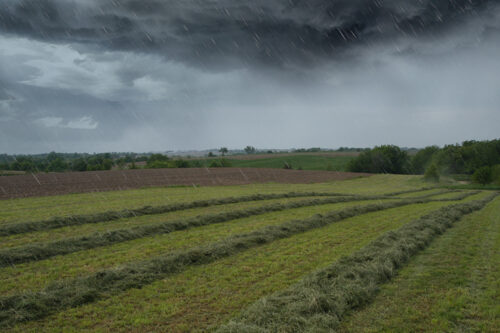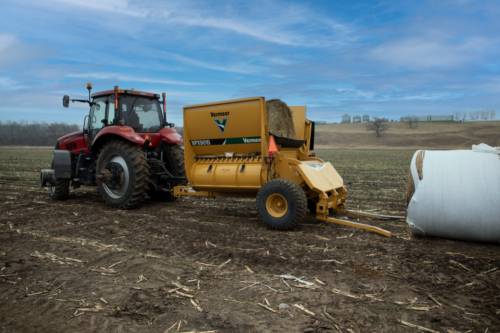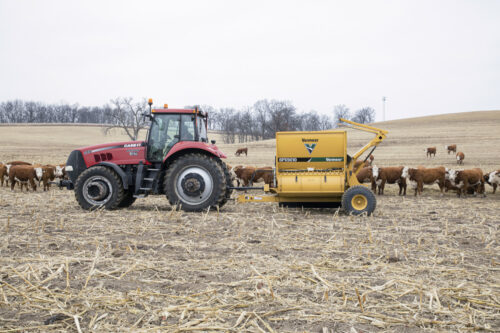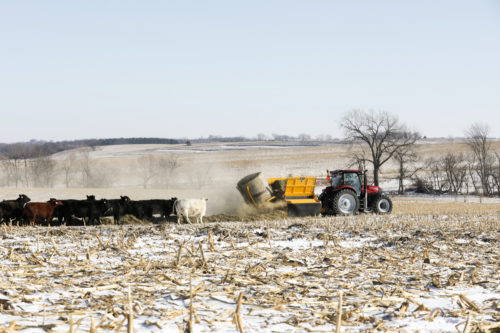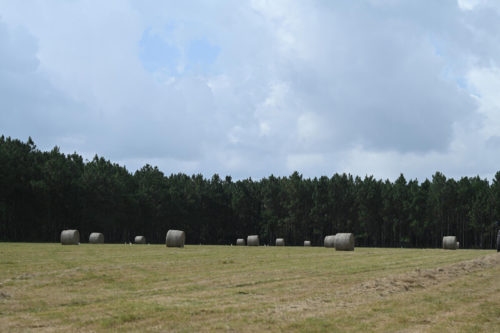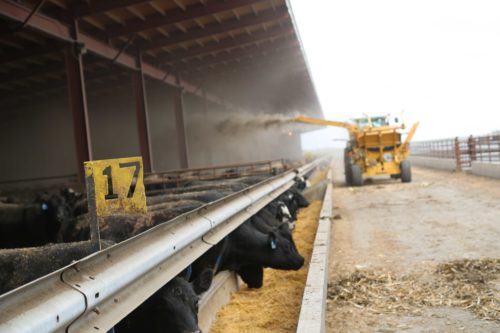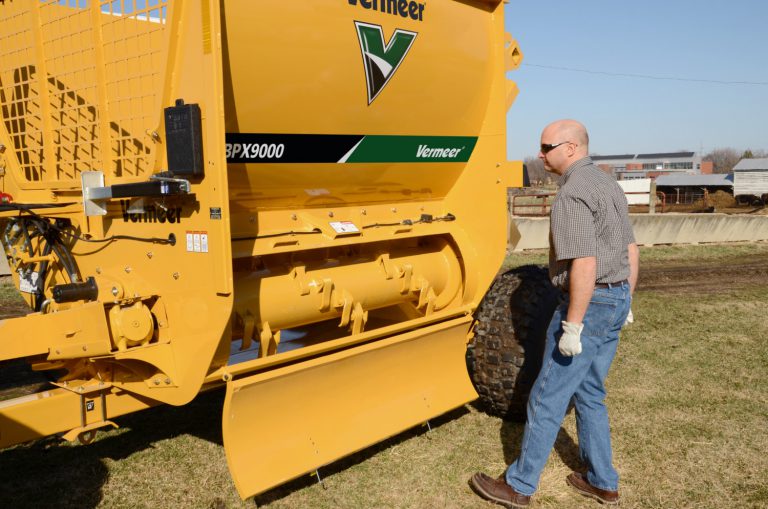
Getting the Most Out of Your Bale Processors
March 2017
Bale processing basics
1. Bale processors maximize hay supplies by reducing hay losses.
2. They also reduce stress and risk of contaminants to your herd while increasing hay palatability.
3. They help provide a healthier and cleaner open-range feeding environment compared to feed rings.
4. They ensure all cattle get an equal opportunity at feeding time.
5. Plus, they give you a fast, effective way to produce a thick, uniform mat of hay or cornstalks for winter bedding.
Bale processor facts
There are two basic styles of bale processors in the field today. Both of them feature a similar rotor design for processing the bale. The primary difference is in how the bale is handled and turned in the tub.
The newer dual feed roller designs use staggered, adjustable dual rollers and promote a more aggressive turning action. However, the vast majority of bale processors sold in the field today feature a simpler slat and chain bed system because the slats are always in contact with some part of the bale.
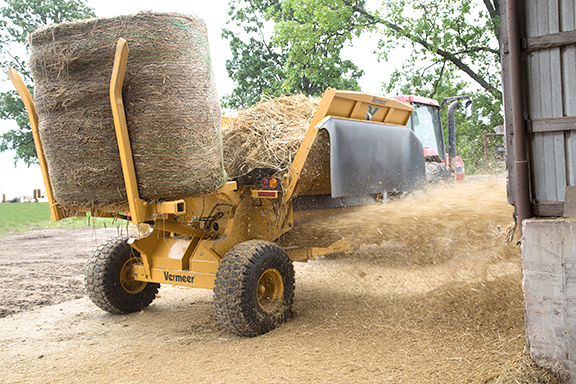
And according to many operators, this allows the feeding process to be more consistent and more user-friendly, especially when handling different types of bales in various sizes, shapes and forms.
Horsepower is crucial. You can never have too much power on a bale processor because if you have a slug of bale going through, it can really pull the tractor down – so hard that the processing action could actually come to a screeching halt.
Remember, the more even and consistent the feeding process, the fewer performance issues there are (particularly if you’re operating a tractor on the lower end of the recommended HP range), and the better your fuel efficiency.
Some processors also offer a “fine-cut” option to reduce the particle size (length) of material even further and give you another level of efficiency.
It may take a little more time to process it down to the recommended 2- to 4-inch size, but the extra time and effort is worth the results: better utilization of hay, better efficiency of hay in beef cows, and if you own a TMR, the pre-cut forage allows a faster and more thorough mix.
How to get the most out of your processor
Read the operator’s manual. It’s all laid out there for you: It tells you how to set it up for maximum operating efficiency. It tells you what you need to monitor; it identifies wear items that need to be checked.
It charts periodic maintenance procedures that need to happen, including recommended frequency (based on time intervals or processed bale counts).
So the first thing you want to do is refer to the manufacturer’s maintenance manual. And make sure you follow through because it can really assist in the performance and productivity of the bale processor.
Some items to consider are:
- Hydraulic cylinders and hoses (kinked or worn)
- Bearings (wheels, rotors, drums)
- Chains (worn or damaged)
- Clutches and clutch components
- Drivelines (lubrication, safety items, foreign material)
- Lube recommendations (grease points, gearboxes, etc.)
- Flail replacements (worn or damaged)
- Proper tire pressure
- Loose or worn bolts and hardware
- How to make axle adjustments for different terrain
- How to remove net wrap and twine from the rotor
- How to make adjustments for processing different crops/conditions
- Safety checks – shields, guards, highway slow-moving vehicle signs and lights
Before you start processing, make sure you adjust your settings based on the material you’re planning to process. For example, if you’re using a slat and chain-style model and processing wet, snow-covered or degraded bales, you’ll want to use a less aggressive setting with a slower chain speed to reduce plugging and tractor power required.
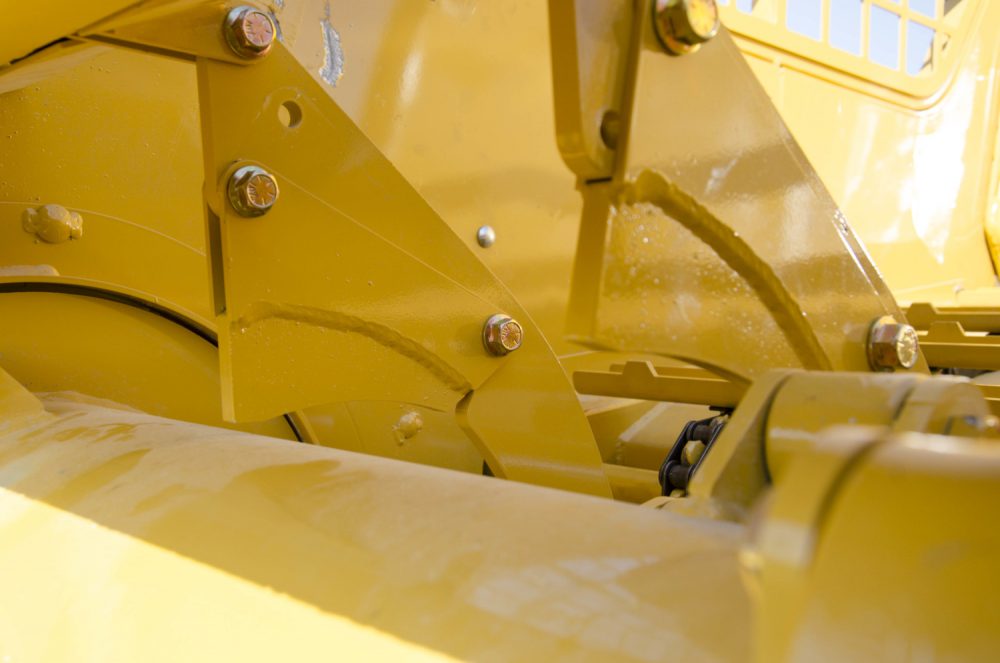
If you’re processing straw, dry bales or new crop bales, you’ll probably want to set up the cut control bars and chain speed in the middle ranges, and then adjust either up or down as needed. If you’re mulching or bedding, you might want to remove some of the cut control bars in order to reduce processing time. On the other hand, if you’re processing cornstalks, you may want to add more bars to allow the flails to thoroughly process looser-formed stalk bales before they have a chance to enter the rotor chamber.
Monitor the flails, and do it regularly based upon what product you process. Different crops cause different wear issues. For example, producers processing cornstalks will see wear sooner than those who process alfalfa. If the flails get too worn and lose their square edge, tractor horsepower goes up, consistency goes down and fuel utilization increases. Also, always remember to replace flails in pairs on opposite sides of the rotor to provide proper rotor balance.
How do you handle net wrap and twine? Cow-calf producers typically remove the net wrap before processing it. But if you’re feeding calves in a feedlot, there’s a good chance some of the net and twine are ground up with the rest of the feed. Typically, the rotor grabs about 90 to 95 percent of the net wrap, so you’ll want to remove the net from the rotor at least every 25 to 35 bales. If you don’t, the net will wrap up around the flails and limit their movement.
If you’re processing twine-wrapped bales, you still need to clean out the twine material, generally after about 60 to 70 bales are processed. Many models have an easy-access door to facilitate net removal.
Low temperature can also impact processing performance, particularly gearboxes. If the temperature is below 0ºF, let your tractor and processor idle for a few minutes (to warm up the oil in the gearbox) before you put it under a full load.
Don’t plan to operate your processor for a while? Make sure you reference the manufacturer’s recommendations, but in general, remove crop material from the tub and remove twine or net wrap from the rotor. Clean mud, dirt, grease and other foreign material from the bale processor with compressed air. (Do not use high-pressure washers or steam cleaners to clean the machine – you may get water in the bearings, ultimately causing failure.) Take time to replace worn or broken parts, safety signs and decals. Store your bale processor in a dry, protected place. If you have to store it outside, cover it with weatherproof material. And, to inhibit rusting, make it a point to repaint areas where paint has been worn. It makes a difference when it’s time to trade or sell.
Be sure to read and understand the manufacturer’s operator’s manual, maintenance and safety message instructions before performing any required maintenance.

